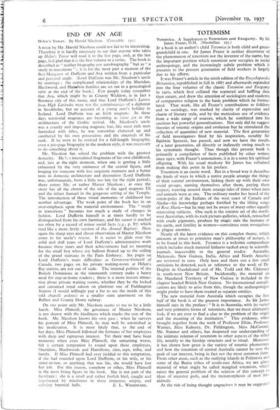TOTEMISM
IF a book is an author's child Totemica is both child and great- grandchild in one. Sir James Frazer is neither discoverer of
the phenomenon of totemism nor the inventor of the name, but the important position which totemism now occupies in social anthropology, and the increasingly subtle problem which it presents to the present generation of field workers is largely due to his efforts.
It was Frazer's article in the ninth edition of the Encyclopaedia Britannica, republished in full in 1887 and afterwards expanded into the four volumes of the classic Totemism and Exogamy
in 191o, which first collated the scattered and baffling data then extant, and drew the attention of sociologists and students of comparative religion to the basic problem which he formu- lated. That work, like all Frazer's contributions to folklore and to sociology, was marked by clarity of expression and charm of literary style, and by the meticulous use of evidence from a wide range of sources, which he combined into his cautious but powerful generalisations. Not only did he suggest theories of totemic origins and evolution but he stimulated the collection of quantities of new material. The first generation of field investigators fired by his inspiration, notably Sir Baldwin Spencer, has passed, and now we have the results of a later generation, all directly or indirectly owing much to his systematic thought. Thus though this present book is primarily a compilation of facts published by other writers since 1910, with Frazer's annotations, it is in a sense his spiritual offspring. With his usual modesty Sir James has refrained from making this point in his preface.
Totemism is an exotic word. But iwa broad way it describes the kinds of ways in which a native people arrange the things of their natural environment, linking them up with their own social groups, naming themselves after them, paying them respect, weaving around them strange tales of times when men and animals were as one. The ordinary reader has heard of the totem-poles of the Indians of the west coast of Canada and Alaska—his knowledge perhaps fortified by the lilting songs of Rose Marie—but he may not be aware of many other equally interesting subjects. One such is the totemic art of the north- west Australian, with its rock picture-galleries, which, retouched with crude pigments, produce by magic rain the increase of the earth, and fertility in women—sometimes even mosquitoes to plague enemies.
Nearly all the latest evidence on this complex theme, which amounts at times to primitive man's philosophy of nature, is to be found in this book. Totemica is a welcome compendium which includes much material hitherto tucked away in scientific journals inaccessible to the general reathr. Australia, Melanesia, New Guinea, India, Africa and North America are reviewed in turn. Only here and there can a few small omissions be detected, such as reference to the work of Dr. Hogbin in Guadalcanal and of Mr. Todd and Mr. Chinnery in south-west New Britain. Incidentally, the material on the Mandated Territory of New Guinea is included in the chapter headed British New Guinea. No international compli- cations are likely to arise from this, though the anthropologist might prefer to have them treated as separate entities.
The new material from Australia which occupies the first half of the book is of the greatest importance. As Sir James himself says in the preface : " It is to Australia, with its varied and very primitive forms of totemism, that we must ultimately look, if we are ever to find a clue to the problem of the origin and the meaning of the institution." This evidence, when brought together from the work of Professor Elkin, Professor Warner, Miss Kaberry, Dr. Piddington, Miss McConnel, Mr. Stanner and others, has deepened our understanding of the intimate relation of totemism to other aspects of the tribal life, notably to the kinship structure and to ritual. Moreover it has shown how great is the variety of totemic phenomena and how the totemism of central Australia cannot be now the peak of our interest, being in fact not the most common form. From other areas, such as the outlying islands in Polynesia and some of the Bantu tribes of south-east Africa, we are given material of what might be called marginal totemism, which raises the general problem of the relation of this concept to ideas of ancestor gods, and the metamorphosis of men into At the risk of being thought ungracious it may be suggested that some readers will. regret the absence of a_rapre definite theoretical analysis in the book.- A very brief summary only is given of the recent important systematic contributions of Radcliffe-Brown and Elkin. Considering Frazer's erudition in totemism and his position as patron saint of all modem studies in the fields of primitive religion and magic it seems a pity that his own views on these contributions are hardly mentioned, and that there is no concluding section in which he discusses the generalisations which he envisages emerging from the comparison of the new with the older material. To mention only one point—the concepts of " typical totemism," " personal totemism," and " sex totemism " now seem ripe for revision, and a synthetic account would be most welcome.
RAYMOND Frain.

















































































































 Previous page
Previous page